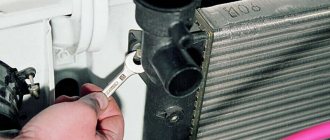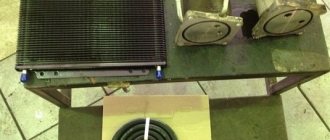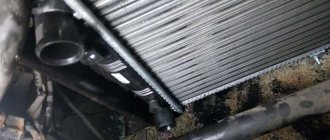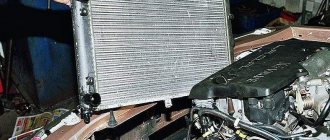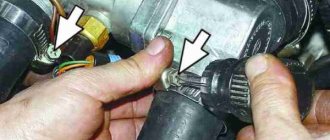Replacing the main engine cooling radiator on cars such as the Lada Granta is done in rare cases, and the main ones are listed below:
- The appearance of a radiator leak, which can be caused by excess pressure in the cooling system
- Damage to pipes, which most often occurs as a result of an accident
If for these or other reasons you had to change the radiator, then for this repair you will need a tool such as:
- heads for 7, 8, 10 and 13 mm
- 17 mm wrench
- ratchet handles or cranks
- pliers
- flat and Phillips blade screwdrivers
Review of Manufacturer Prices
Technical parameters of the main radiator: length 560 x width 306 mm x height 20 mm.
| Name | Price, rub.) |
| Original 21901-1300008-11 | From 5500 |
| 21903-1300008-14 | From 4500 – 4800 |
| 21903-1301010-14 | —/— |
| 150925A2020 | —/— |
| 21900-1301010-14 | —/— |
| 21900130001004 | —/— |
| Lada Granta LUZAR 2190-1301012-01 | From 4600 |
| VAZ-2190 AvtoVAZ OJSC 546532532 | —/— |
| AvtoVAZ 21900-1301012-82 | —/— |
| RSO VAZ-2190 Lada Granta SB with electric fans and AvtoVAZ pipes | From 10100 |
| VAZ-2190,91,92,94 LUZAR universal 25643542 | From 6200 |
| VAZ-2190, 91, 92, 94 LUZAR 48454234 | From 4900 |
Related link:
How to buy a Lada Granta on credit
*prices are current as of November 19, 2018.
Radiator dismantling in Kalina
To remove the designated assembly and related components, you will need to use the following tools:
- wrench "10" (socket type);
- pliers with thinned grips;
- Phillips screwdriver;
- If the Lada Kalina is equipped with an air conditioning system, then we additionally stock up on a set of Torx (star profile).
- Disconnect the power connector from the system fan.
- Let's dismantle this unit. It is held on the radiator with 4 bolts. To unscrew them, you will need to use a “10” key. Extraction is carried out in the upward direction.
- Next, we move on to removing the pipes from the radiator fittings. We loosen the clamps using pliers or a screwdriver. We use the same wrench to unscrew the two nuts that hold the radiator assembly in the seat.
- Now we tilt the product slightly towards the engine and lift it up.
When dismantling the unit on a Lada Kalina equipped with air conditioning, you will need to resort to removing additional components that are directly attached to the radiator. To carry out this activity, you should stock up on a key with an asterisk profile.
Recommendations for the selection of parts and components
The range is represented by domestic manufacturers, originals and high-quality analogues. The final choice is up to the owner of the technical device.
Service center technicians strongly recommend purchasing original parts. The service life and manufacturing quality of factory components are an order of magnitude higher than their analogues.
Before purchasing, carefully check the spare part catalog numbers with the actual data in the instruction manual. If necessary, get free consultations from service station specialists.
Lately it has become popular to order parts for subsequent installation directly in workshops. There are many advantages of this choice: prompt delivery, professional installation, quality guarantee.
Eliminating air jams
The design of the cooling system in the VAZ-1118 has one unpleasant drawback - the tendency for the circuit to become airy. This can lead to overheating and engine damage. Here we recommend resorting to minor system upgrades. You need to act when the liquid is drained.
- First we replace the thermostat. Instead of a standard product with five holes, we install a component with six such holes.
- We add a refrigerant filter to the circuit.
- We install a shut-off valve on the pipe leading to the stove.
These actions are not capable of radically transforming the system. Experienced owners of LADA Kalina have moved further in this matter. They add steam exhaust pipes, install a forced fan activation button, etc. To install the designated outlet, the diagram looks like this: we cut a tee into the pipe leading to the expansion tank. It is connected through a separate hose to the pipe of the throttle body heating unit. We place the second tee in the return from the radiator of the heating system and connect it with an expansion tank. Now you know how to remove, as well as how to change the radiator, and fix other problems yourself.
Refinement of the cooling system
Domestic cars are far from perfect, that's a fact. Lada Priora was no exception in this regard, having inherited many shortcomings from the legendary “ten”. One of them is an unfinished cooling system.
There are several ways to quickly and without financial costs modify the SOD on Priora.
- Installing a 6-hole thermostat (stable maintenance of coolant temperature).
- The use of Kalina SOD on Priora will reduce the pressure in the system and provide quick warm-up at subzero temperatures.
- Installing a larger or additional water pump to improve coolant circulation efficiency.
- Use of multi-speed and silent forced cooling fan.
- Changing the firmware of the control unit so that the fan operates at a lower temperature.
Refining the cooling system of the Lada Priora is a feasible task even for novice car enthusiasts. The SOD has a simple design with a minimal set of components. Thanks to this, the system is relatively reliable.
Source
Replacing the generator on the Lada Grant with an 8-valve
Preparatory stage
Tools, materials:
- metal mounting blade;
- set of auto tools;
- rags;
- rust remover WD-40.
Sequencing:
- We place the car within the perimeter of the repair area, provide priority safety measures, and fix the wheel chocks.
- We remove the terminals from the battery to avoid a short circuit in the circuit (key to “10”).
- From under the bottom of the car, unscrew the 8 bolts securing the oil pan protection and remove it.
- Disconnect the block with wires from the converter (generator).
Block with wires
- Remove the rubber cap and terminals from the back of the converter.
- The key is set to “13”, unscrew the top bolt - the generator position lock.
- We move the converter forward until it stops against the radiator.
Moving the converter
- From under the bottom of the car, unscrew the second bolt - the clamp, and remove it.
- Having loosened the fixation of the converter, we remove the belt from the pulleys.
We remove the generator, carry out preventive measures (replace with a new one), and assemble the structure in the reverse order.
The principle of operation of the cooling system
The main task of the cooling system is to ensure optimal temperature conditions for the Priora engine. The vehicle is equipped with a system with forced circulation of coolant. Its main element is the cooling jacket through which the liquid circulates.
To maintain the integrity of the shirt, you should constantly monitor:
- quantity
- quality of the liquid (for example, Antifreeze).
If its amount is too low, the system will not be able to properly maintain the thermal regime of the power plant, and it will overheat. Antifreeze heavily diluted with water will not have adequate frost resistance, and in winter the shirt may freeze.
Another important element of the system is the liquid pump. The purpose of the pump is to ensure the circulation of Antifreeze throughout the system. The Priora pump is belt driven from the crankshaft. The condition of the pump also needs to be constantly monitored. If the bearing in it starts to fail, it will jam. The result of wedging will be:
- inability to maintain optimal temperature;
- the likelihood of a timing belt break.
This, in turn, will damage the gas distribution mechanism.
Until the engine reaches the desired temperature, the liquid circulates in a small circle, that is, it moves only along the jacket. When the temperature approaches normal, the liquid will begin to move in a large circle. In addition to the cooling jacket, it also includes a radiator with a fan installed on it. The cooler starts working only when the liquid temperature begins to exceed the permissible limit. For monitoring, a temperature sensor is built into the cooling jacket, also known as a fan switch on sensor.
The thermostat is responsible for which circle the Tosol moves in. Incorrect operation of the thermostat or its jamming will either lead to overheating of the unit or to the fact that it will not be able to reach the optimal thermal conditions.
This system works on a Priora like this: while the power plant is cold, the thermostat is in a position that blocks the channel going to the radiator. The liquid, thanks to the pump, circulates through the cooling jacket. As it warms up, the thermostat begins to open the channel slightly, and liquid begins to flow into the radiator to reduce the temperature of the liquid itself.
In the summer, when idling in a traffic jam, the air flow passing through the radiator is insufficient, and the temperature continues to rise. The fan switch-on sensor monitors this indicator, and if it begins to exceed the permissible limit, it turns on forced cooling of the radiator, which additionally creates an air flow to ensure cooling of the Antifreeze.
Source
Reviews
| № | Positive |
| 1. | Mikhail: I have run over 80,000 km on my car, there are no complaints, the cooling system is working as normal. I follow the manufacturer's instructions - replace antifreeze every 75,000 km. |
| 2. | Vladimir: in two years of active driving, I replaced the thermostat once. I don’t consider this a significant breakdown, since this is a normal occurrence for domestic cars. |
| 3. | Kirill: The car is a year and a half old, I bought it at a dealership. There are no complaints, all mechanisms work as usual. Breakdowns happen, but they are not so significant and can be easily fixed on your own. |
| 4. | Gennady: after buying the car from the dealership, I immediately replaced the antifreeze with a new, imported one. Domestic is of low quality and quickly loses its properties. |
| 5. | Vasily: I am satisfied with the quality of assembly and manufacturing of the Lada Granta (16 valves). As for a domestic manufacturer, this is very good, it cannot be compared with Kalina, Priora. I fix minor damage myself. |
| 6. | Konstantin: within a year and a half of using the car, I replaced two clamps on the cooling system pipe. I don’t consider this a defect; it’s normal for Lada. |
| 7. | Victor: I’ve heard negative reviews about Granta, I think they are unfounded. You should always follow the instructions in the instruction manual, then everything will be fine. |
| Negative | |
| 1. | Alexander: the radiator leaked at 39,000, corrosion formed, luckily I replaced it with a new one under warranty. After 15,000 km. The thermostat has failed. Lots of trouble with the Grant, it’s better to pay a few tens of thousands extra and buy a Renault Logan. |
| 2. | Vladislav: Two years have passed since I bought the car, and I have already had unscheduled repairs at a service station several times. The build quality is crude, many defects are not eliminated from generation to generation. |
| 3. | Igor: many components and assemblies do not maintain their service life and wear out prematurely. |
Conclusion The average service life of the cooling system radiator on a Lada Grant is over 100,000 km. Provided you follow the manufacturer's recommendations and replace the antifreeze, no problems arise after 75,000 km.
A number of owners save on maintenance, buy cheap analogues, lubricants, liquids, as a result of which irreversible processes begin. The mechanisms fail and work unstably.
Source
Adviсe
To prevent problems with the heater core, you need to carefully monitor it. For example, from the first days of buying a car, periodically look under the car to see if there are dark spots there. And in the engine compartment it would be a good idea to observe the condition of the cooling system hoses. If you notice traces of antifreeze in any of these places, you need to immediately seek help, or carry out repairs yourself.
If possible, the hoses for connecting the heater radiator should be replaced with new ones, having coated the connection points with sealant. But some do not agree with this opinion. After all, sealant from the hose can get inside the cooling system and cause damage to the pump. As a result, the timing belt will break and the valves will meet the pistons.
Replacing the stove radiator on a Lada Granta with your own hands + video
Lada Granta has become a really popular car. And, in many ways, this happened thanks to the affordable price and good components. For example, the stove installed on the Lada Granta is quite good, as it warms up the interior to the required level very quickly. AvtoVAZ engineers did a very good job on this issue, since for our harsh winters the issue of high-quality heating of the interior is very relevant.
| TOP 15 most useful products for Lada Granta - OUR EXPERIENCE! |
- 1 Dismantling the Lada Granta heater radiator 1.1 Installing a new Lada Granta radiator
- 1.2 Selecting a new heater radiator (tested articles)
- Ratchet driver;
- Extension;
- Crosshead screwdriver;
- Cooling system sealant;
- Head for eight, ten, thirteen;
- Slotted screwdriver;
- Pliers;
- Powerful wire cutters or small grinder;
- Pipes for the cooling system with an internal diameter of 16 and 18 mm (length 1 meter);
- Six worm clamps with a grip range of 15-25 mm.
- After the engine has cooled, unscrew the coolant expansion tank cap. The lid must be opened to equalize the pressure in the system.
Loosen the coolant drain plug on the engine block. The plug is located under the ignition unit.
Place a container to collect the liquid and unscrew the cap completely. Head plug for thirteen.
Press the lock and remove the power connector from the electronic gas pedal.
Unscrew the three nuts securing the gas pedal and remove it. Ten head nuts. Press the latch and disconnect the power connector for the brake light button.
Disconnect the brake pedal from the brake booster. To do this, remove the locking ring using pliers and remove the pin that fits through the hole in the pedal and the VUT bracket.
Unscrew the two screws securing the plastic cover that makes access to the radiator difficult. Phillips head screws.
Unscrew the three nuts securing the gas pedal bracket and remove it. Ten head nuts.
In the engine compartment, disconnect the power connector to the mass air flow sensor. Loosen the clamp on the pipe going to the intake manifold. Next, disconnect the plastic pipe for the air intake and remove the air filter housing assembly. Clamp for a slotted screwdriver or 8mm head.
Loosen the clamp and remove the pipe coming to the thermostat. Also remove the pipe connected to the pump. Head clamps for thirteen.
Remove the insulation from the engine shield so that it can be reused.
Cut or saw through the two aluminum tubes that go to the radiator. Cut off the tube that is closest as short as possible.
Remove the radiator from its seat. When dismantling, it is best to place the brake pedal between the radiator tubes.
Glue the seal onto the new radiator, just like it was on the old one. Most often, the seal comes with the radiator.
Cut the pipes on the new radiator as shown in the photo below.
Clean the seat and install the radiator.
Place two clamps on the radiator tubes and lubricate the pipes with a sealing compound. Insert the pipes from the side of the engine compartment. Direct the heads of the clamps towards the radiator so that there are no problems with the plastic cover during installation.
Glue the insulation near the pipes. Mount the gas pedal bracket and secure with three nuts. Install the plastic cover for the radiator pipes and secure with two screws. Connect the brake pedal to the vacuum booster. Connect the brake light button power connector. Install the gas pedal and secure with three screws. Also don't forget to connect the power connector. Cut the pipes to size. Trim the pipes so that they are not strained and there are no kinks. Fill the radiator with coolant.
Lubricate the pipes with a sealing compound and secure them to the thermostat and pump.
Install the air filter housing and connect the mass air flow sensor. Pass coolant through a sieve and pour into the system. Start the engine and check connections for leaks.
You can see the procedure for replacing the Lada Granta heater radiator in this video:
Control unit for heating and ventilation system Lada Granta
The heating, air conditioning and ventilation system of the Lada Granta is a single complex that provides the most comfortable conditions inside the car, regardless of weather conditions and driving conditions.
The system control unit panel is installed on the instrument panel console.
Heating and ventilation system control unit:
1 – air temperature regulator;
2 – fan operating mode switch;
3 – air flow distribution regulator;
4 – air recirculation control lever;
5 – rear window heating switch.
Outside air can enter the car interior through the central and side deflectors of the heating and ventilation system, into the area where the feet and head are located and onto the windshield.
The intensity of air supply into the cabin is regulated by turning the handle of the fan operating mode switch. This turns on one of four fan speeds. Turn the switch handle clockwise to increase the fan speed.
The position of the flow distribution control handle sets the following directions of air flow in the cabin
1. The air flow enters the lower part of the passenger compartment, into the driver’s and passengers’ foot areas, as well as through the air nozzles to the windshield and front door windows of the car;
2. The air flow through the blower nozzles reaches the windshield and windows of the front doors of the car;
3. The air flow through the side and central deflectors enters the upper part of the car interior to blow air over the driver and passengers.
4. The air flow enters the lower part of the cabin, to the driver’s and passenger’s foot areas.
Air temperature regulator
By turning the air temperature control knob, change the temperature of the air entering the cabin.
To increase the air temperature, turn the control knob to the left, to the red sector of the scale, and to decrease the air temperature, turn to the right, to the blue sector. With its help, you can determine where the stove gets air from - from the interior or outside. You need to take it from the interior when there is an unpleasant smell outside, or you need to warm up the car faster.
Recirculation system control lever
To turn on the recirculation mode, move the lever to the extreme right position. When the recirculation mode is turned on, outside air does not enter the cabin, and the air blower fan circulates air inside the cabin. This mode is used to quickly warm up the interior in the cold season, as well as when the surrounding air is dusty and gassy.
To allow outside air to enter the cabin, move the lever to the extreme left position.
The directions and intensity of air flows through the side and central deflectors of the ventilation and heating system are regulated by correspondingly rotating the guide vanes until they are completely open and rotating the deflector body.
Note:
It is not recommended to turn on the recirculation mode for a long time while the car is moving, as this usually leads to fogging of the windows.
Heated rear window switch
The heated rear window is turned on and off by pressing the button when the ignition is on. It is turned on by a button located below the handle.
Lada Granta car engine
The first Lada Granta sedan cars had 2 configurations - standard and norm. Under the hood of the grant, an 8-valve engine with a volume of 1.6 liters is installed. There are two modifications of it - 80 hp. and about 90 hp. This power unit accelerates the Grant to 100 km/h in 12 seconds, which is not bad for a budget car. Combined cycle consumption is no more than 7.3 liters per 100 km. In the suburban cycle, consumption drops to 5.5-6 liters. at a cruising speed of 100-110 km/h. With all this, the engine complies with the Euro-4 eco-standard, and work on the development of Euro-5 is gradually beginning. With the appearance of the “Lux” configuration on the Grant, a version of the engine from Renault coupled with an automatic transmission will be available. Such an engine will have a power of 98 hp.
If the fan does not turn on
If the RTD has risen to 100 degrees and the indicator needle has entered the red part of the scale, this indicates overheating. Perhaps this phenomenon occurred due to the fact that the fan did not work. If you find that when it overheats, the fan does not start working and the temperature does not drop, you need to check the serviceability of the fan itself. It is necessary to determine whether the switch-on sensor is triggered when the normal RTD is exceeded? First, start the engine and disconnect the wires from the temperature sensor that is installed on the engine. When the wires are disconnected, forced cooling should work. If this does not happen, most likely the fault lies in the electric motor of the device. How to check the operation of the fan, watch the video.
This malfunction is quite easy to fix: you just need to replace the sensor. After replacing it, check if the fan turns on. To do this, start the engine. When the RTD reaches normal levels, do not turn off the engine until the temperature exceeds the norm. As soon as this happens, the fan should be activated. If the fan operates at a temperature above 97 degrees, but less than 100 degrees, then the system is functioning properly.
Starter operating rules
According to AvtoVAZ standards, the time between failures is not regulated for starters, therefore, this indicator can be considered infinite. But they still have to be changed, and this is due to car owners violating operating rules. Car enthusiasts often complain about the quality of starters, pointing out that they are not able to last more than 50,000 km on domestically produced cars. But only a few of them know how to use this device correctly and correctly. Following a few simple recommendations will help you protect yourself from a whole list of starter malfunctions:
- When starting the engine, it is necessary to hold the PU for 10 to 15 seconds; restarting is carried out no earlier than half a minute later. Frequent and continuous operation of the PU leads to systematic overheating of the overrunning clutch, thereby provoking its premature wear. Remember - if there are three consecutive unsuccessful attempts to start the engine, the problem should be looked for in the wiring, fuel equipment or ignition system;
- After starting the engine, immediately turn off the starter, for which you will need to release the key in the lock;
- Many experienced car owners do not recommend using PU when temporarily driving a car (this is what novice drivers often do when the battery is discharged or there is damage to the power supply circuit).
Work resource
The manufacturer states that the 126 by 16 valve engine can operate stably for 200 thousand kilometers. After this limit, the power plant requires major overhaul. But do not forget that AvtoVAZ is a real lottery; for some Priora owners, the engine caught a wedge at 2 thousand. But if you take care of your Lada car, regularly perform maintenance and replace damaged components, then you can safely count on a service life of 150-200 thousand km.
The resource of the power plant is influenced by many factors, here are some of them:
- Overheat. Running the engine on a Priora at elevated temperatures significantly reduces its service life. The operating temperature, which we will talk about in the next section, must be maintained at the same level.
- Fuel. The instruction manual indicates what kind of gasoline should be poured into engine number 126 with 16 valves. It is also recommended to visit only trusted gas stations that will not fill you with diluted fuel.
- Engine oil. Everything is simple here - change the lubricant in a timely manner and buy high-quality oils, then the service life will be 150-200 thousand km. For the 16 valve unit 126, semi-synthetics (Lada recommendation) and synthetics are suitable. The oil needs to be changed once a year or every 15 thousand kilometers; as you can see, the fluid does not have a long service life.
Replacing the Lada Granta generator - KZATE with Bosch. Comparative characteristics and disadvantages
| Characteristics | KZATE 115A 2170-10 | Bosch 2170-13 |
| Maximum current (output) at 14.5 V / 6000 rpm | 115 | 110 |
| Voltage setting limits at a speed of 2500 rpm and a current of 5.0 A | 13.6 – 15.2 | 13.6 – 15.2 |
| Gear ratio according to the principle: motor - converter | 1 : 2.4 | 1 : 2.4 |
Due to its smaller height, Bosch 110A is 10 mm lower than its analogue. Despite the minor advantages, BOSCH has one “fat” drawback - there is no possibility of quick (cold) replacement of the diode bridge in the event of its failure.
The electrical contacts are soldered into the bridge; quick replacement of the rectifier on the road will not work. At KZATE it is quite possible and acceptable to replace the rectifier on the road.
Addresses of companies providing generator replacement services (Moscow, St. Petersburg, Kyiv regions)
| № | Name | Address |
| 1. | "Autopoints" | Moscow, Varshavskoe highway, 33 https://avtotochki.ru/ |
| 2. | "ZenitAuto" | Moscow, metro station Perovo, Kuskovskaya st., 20A (next to the Enthusiasts Highway) https://www.zenitauto.ru/ |
| 3. | "RemZone" | St. Petersburg, Vasilievsky Island, st. Uralskaya, 17A https://www.spb-remzona.ru/ |
| 4. | "Autopoints" | St. Petersburg, Lesnoy Avenue, 78 https://spb.avtotochki.ru |
| 5. | "Dzigora Complex" | m. Darnitsa, st. City Shalet 1A https://dzigoracomplex.kiev.ua/ |
| 6. | "VseSTO" | Kyiv, st. Kikvidze 43 https://vse-sto.com.ua/ |
Difference between belts of 16 and 8 valve engines
For Lada Granta models, an alternator belt with the following markings is used:
- 1118-1041020-07: search index 6RK 823, length 823 mm, thickness 3.0 mm;
- 6PK1123 with air conditioning;
- 6PK1113 without air conditioning, with power steering;
- 6PK745 without air conditioning, without power steering.




